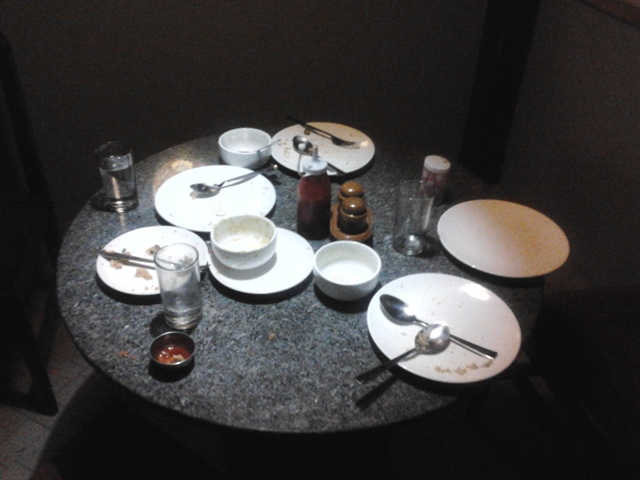This is Day 2 of Nepal Travelogue (May 14, 2013)
Ton-Tonn-Tonnn!
The cold night
was also not so eventless as Misha was
missing دادی, grandmother, and Urooba felt a jinn in the room in addition to sighting a
lizard! On top of it, the not-helping howls from the nearby jungle were so piercing
as if some of the zombies were standing right beneath the window, thankfully on
the second floor!
Surprisingly,
all this alien feeling would quickly vanish as the sunrays started peeking in
from the curtains. And the same Cultural Shock, that ton-tonnn-tonnnnn, sneaked into our routine. Life became the interval between those two tonnnnns and we
literally started waiting for the next one!
This temple bell, or ghanta, is an integral part
of Nepali culture, which a devotee knocks while entering into the arena to
appease Gods and to hush evil spirits away. During the early days of Islam also,
it was contemplated to use bell before the prevalent prayer-call, azaan, came into practice. In India, as I heard from my grandparents,
any of the two sounds could quickly become a bone of violent contention,
unfortunately.
 |
| These Heavy Brass Bells Are Omnipresent around Nepal |
 |
| In Budhanilkantha, the Sound Resonates Longer Due to Surrounding Hills |
Budhanilkantha’s Temperature Zone: Min 15° Max
25°C
Even in summers weather was pleasant around Kathmandu and resembles to one in Pakistan's mountainous North. At both places, one could hardly find a ceiling fan. Natural air-conditioning and no hefty bills!
Tough Times: Trekking and Babysitting
The one+
hour trek to the Chandra Ban Eco Resort, where Urooba
enrolled for yoga sessions, might be a walk in the park for avid trekkers but frankly
speaking it was tough for our lazy Karachiite physique, especially on the
first day. The steep slope and the enroute scenery were both breathtaking; one literally
and the other figuratively!
Nonetheless, after
climbing up, we got the right to comment sarcastically on those coming to yoga
by taxi!
For the next three days, Urooba got busy learning new routines handing over the kids duo to me. I guess kids enjoyed Abbu doing babysitting mostly because they got the liberty to dirty their hands around the resort. The resort was purposefully built for nature lovers with fruit orchids around and had an appeal for long-term holidaymakers with deep pockets.
The Italian owner was a bit rude at us initially when I rushed to the lobby due to sudden and heavy rains. But when, Valarie, the yoga organizer, and her associates offered us their self-catering apartment there for the daytime, he came to good terms and we had a couple of pleasant exchanges.
 |
| The Yoga Trek: from Budhanilkantha We Had to Walk to the Surrounding Hills |
 |
| Walking Through the Town of Budhanilkantha |
 |
| Budhanilkantha's Main Bazaar |
 |
| We Found this Housing Style Popular Around Kathmandu |
 |
| Misha was Clueless Why Walk So Much |
 |
| An Aerial View of the Chaotic Kathmandu |
 |
| Finally We Reached There |
 |
| Another View of Kathmandu from the Yoga Resort |
 |
| The Upscale Chandra Ban Eco Resort, Budhanilkantha |
 |
| Fauna in the Resort |
 |
| Babysitting: It was My Turn! |
 |
| Kids also Got Solace from Strict Mamma! |
 |
| Yoga is a Nepalese Specialty |
Coincidence: Meeting Flossie
Before the
trip, I received an email from an overland traveler Flossies, who would cross
Pakistan during her East-West expedition right from Hong Kong and all the way
to London, by road!
Coincidentally, we met her at the same yoga class! Recently, she crossed-over to Iran from
Quetta-Tuftan border, and Flossie if you are reading this please do share your
experiences of traveling through the dangerous Pakistan so that reader may
benefit from your brave accounts!
Today’s Bills – in Nepali Rupees
| 420 |
|
Food |
|
Milk, snacks,
etc |
| 420 |
|
Total for May 14,
2013 |
|
|
| 5190 |
|
Total as of Today |
|
|
* Room charges and hotel's food bill will be included in Day 4 at check-out
Traveler’s Tip # 4: Best Season to Visit
Nepal
October onwards,
when monsoon finishes washing the Himalayan skyline, is the best period to
visit Nepal. Due to the enhanced visibility and conducive weather conditions, trekkers
from all around flock to the mountains pushing the prices upwards.
Pre-monsoon,
which is before May, is the second best season, which we also chose. This time
of the year is great to enjoy the colorful Nepali culture without getting bankrupted;
however, clouds will restrict panoramic views. If you choose this part of the
year, do watch-out for festivals like Buddha Jayanti.
Traveler’s Tip # 5: Budhanilkantha’s Dairy
For dairy
lovers Budhanilkantha gives a reason to
visit. Although Pakistan is also rich in dairy but what we tried there
was so amazingly refreshing that we could never have had enough of it. In addition to pasturized milk, the shop
there was also selling fresh yogurt, homemade varieties of butter and cheese, ghee,
and even barfi – the local sweet.
Traveler’s Tip # 6: Danger Dog
In
Budhanilkantha, and everywhere in Nepal, we got irked by dogs, both stray and trained,
and of all sizes. So beware, and confident, while strolling around and please
share a tip or two on how to avoid this nuisance!













































